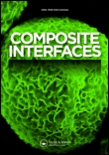
COMPOSITE INTERFACES
Scope & Guideline
Pioneering Research in Composites and Ceramics
Introduction
Aims and Scopes
- Interface Characterization and Optimization:
Research on the properties and behavior of interfaces in composite materials, including mechanical bonding, adhesion mechanisms, and the effects of surface treatments on interfacial performance. - Nanocomposite Development:
Focuses on the incorporation of nanomaterials (e.g., graphene, carbon nanotubes) into polymer matrices to enhance mechanical, thermal, and electrical properties, exploring the synergy between nanofillers and matrix materials. - Sustainable and Biocomposite Materials:
Explores the use of renewable resources and environmentally friendly materials in composite formulations, emphasizing the mechanical performance and durability of biocomposites. - Advanced Fabrication Techniques:
Investigates novel manufacturing methods, including additive manufacturing, to create composite structures with tailored properties and complex geometries. - Application-Specific Composites:
Examines composites designed for specific applications such as aerospace, automotive, biomedical, and construction, analyzing their performance under relevant conditions. - Multiscale Modeling and Simulation:
Utilizes computational techniques to predict the behavior of composite materials at various scales, from molecular dynamics to macroscopic modeling, to understand the influence of interfacial interactions on overall material performance.
Trending and Emerging
- Smart and Multifunctional Composites:
Research is increasingly focusing on composites that not only provide structural integrity but also possess additional functionalities such as self-healing, sensing, and energy storage capabilities. - Advanced Nanocomposite Systems:
The integration of advanced nanomaterials, including 2D materials like MXenes and functionalized nanoparticles, is a growing area of interest due to their unique properties and potential applications. - Sustainability and Recycling of Composite Materials:
An emerging theme is the development of sustainable composites and methodologies for recycling existing composite materials, addressing environmental concerns and resource efficiency. - Biocomposites for Biomedical Applications:
There is a rising interest in biocomposites designed for biomedical uses, focusing on their biocompatibility and the potential for tissue engineering and drug delivery systems. - Machine Learning and AI in Material Design:
The application of machine learning and artificial intelligence techniques to predict material behaviors and optimize composite formulations is becoming a significant trend, enhancing research efficiency and innovation. - Interfacial Engineering for Enhanced Performance:
Customizing the interfacial properties of composites through innovative surface treatments and modifications is gaining attention, aimed at improving overall material performance and durability.
Declining or Waning
- Traditional Material Reinforcement Techniques:
Research focusing on conventional reinforcement methods (e.g., glass fiber) is becoming less prominent as newer materials like carbon nanotubes and graphene gain attention for their superior properties. - Generalized Composite Characterization Methods:
Studies that employ broadly applicable but less innovative characterization techniques are declining, as more specific and advanced methods become the standard. - Static Mechanical Properties:
There is a noticeable reduction in research solely concentrating on static mechanical properties, with a shift towards dynamic and multifactorial analyses that account for environmental impacts. - Micromechanical Modeling without Novel Innovations:
Papers focusing on basic micromechanical modeling techniques without incorporating new materials or methodologies are seeing reduced interest, as researchers seek more advanced predictive models. - Low-Impact Applications of Composites:
Research on low-performance composites for non-critical applications is declining, as the field increasingly focuses on high-performance materials for demanding applications.
Similar Journals

JOURNAL OF CERAMIC PROCESSING RESEARCH
Unveiling Breakthroughs in Ceramic TechnologiesJOURNAL OF CERAMIC PROCESSING RESEARCH, published by the Korean Association for Crystal Growth, Inc., serves as a vital source of scholarly communication in the field of ceramics and composites. With an ISSN of 1229-9162, this well-regarded journal aims to advance knowledge through rigorous research and publication of innovative studies that push the boundaries of ceramic processing technologies. Indexed in Scopus and boasting a 2023 Q3 ranking in the ceramics category, it provides a platform for researchers to disseminate their findings and engage with emerging trends in material science. The journal reflects a commitment to contributing to the scientific community, emphasizing the importance of interdisciplinary collaboration and advancements in fabrication techniques. Although it operates under a traditional access model, the journal is a beacon for researchers, professionals, and students, inviting them to explore breakthroughs from the years 2000 through 2024 and beyond.
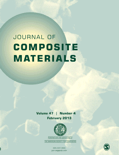
JOURNAL OF COMPOSITE MATERIALS
Pioneering Insights in Composite EngineeringJOURNAL OF COMPOSITE MATERIALS, published by SAGE PUBLICATIONS LTD, is a premier academic journal dedicated to advancing the field of composite materials. With a long-standing history since 1967, this journal serves as a vital platform for researchers and professionals in the areas of ceramics and composites, materials chemistry, mechanical engineering, and mechanics of materials. The journal's impact is further underscored by its Q2 quartile ranking in various categories as of 2023, alongside notable Scopus rankings in multiple engineering and material science disciplines. Though it currently lacks Open Access options, its rigorous peer-review process ensures the high quality and relevance of its published research. This journal is instrumental in fostering innovation and promoting collaboration among academics and industry professionals, making it essential reading for anyone involved in materials science and engineering.

Functional Composites and Structures
Fostering Excellence in Functional Composites.Functional Composites and Structures is a prestigious academic journal published by IOP Publishing Ltd, dedicated to advancing the field of materials science with a focus on innovative composite materials and their structural applications. Established in 2019 and running through 2024, this journal uniquely bridges several disciplines, consistently ranking in the Q2 quartile across key categories including Ceramics and Composites, Electronic, Optical and Magnetic Materials, and Mechanics of Materials. With a commendable Scopus rank that places it within the top tiers of its field, the journal is instrumental for researchers, engineers, and scholars seeking to explore the latest developments in material properties, functionality, and applications. Although access options are not specified, the open-access nature of the journal promotes wider dissemination and engagement with cutting-edge research. As the demand for smarter, more efficient materials continues to grow, Functional Composites and Structures serves as a vital resource for fostering collaboration and driving innovation in material sciences.

POLYMERS & POLYMER COMPOSITES
Pioneering Insights in Polymer ApplicationsPOLYMERS & POLYMER COMPOSITES, published by SAGE Publications Ltd, is a prestigious journal dedicated to the exploration of significant advancements in the diverse fields of polymers, composite materials, and their innovative applications. With an ISSN of 0967-3911 and E-ISSN of 1478-2391, this journal plays a crucial role in the academic community, boasting an impressive ranking in the Q2 quartile across pivotal categories such as Ceramics and Composites, Materials Chemistry, and Polymers and Plastics in 2023. Positioned in the United Kingdom, it serves as a vital resource for researchers and professionals, providing insights into current trends and future directions in material science. Despite its availability not extending to Open Access, the journal aims to promote rigorous peer-reviewed research, thus fostering knowledge and collaboration among scholars. With publication convergence from 1993 to 2024, POLYMERS & POLYMER COMPOSITES stands as a cornerstone for those pursuing advanced understanding and excellence in material innovation.

MATERIALS SCIENCE-POLAND
Championing Accessibility in Scientific DiscoveryMATERIALS SCIENCE-POLAND, published by SCIENDO, is an esteemed open access journal dedicated to the rapidly evolving field of materials science. Since its inception in 2002 and transitioning to an open access model in 2015, the journal has been a vital platform for researchers and professionals to disseminate their findings and contribute to the scientific community. With an ISSN of 2083-134X and an E-ISSN of 2083-134X, it spans a comprehensive range of disciplines, focusing on condensed matter physics, materials science, and mechanical engineering among others. In the 2023 rankings, it holds a position in the Q4 and Q3 quartiles across various categories, showcasing its relevance and ongoing contribution to these fields. Researchers benefit from its accessibility, enabling wider reach and engagement with contemporary topics in material innovation and applications. As the journal continues to evolve until 2024, it remains a cornerstone for scholars looking to advance their knowledge and research in materials science.
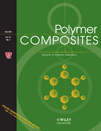
POLYMER COMPOSITES
Shaping the Future of Composite TechnologiesPOLYMER COMPOSITES, published by WILEY, is a leading journal dedicated to advancing the fields of materials science and engineering through the exploration of polymer composite materials. With its foundation dating back to 1980, this esteemed journal has continuously provided a platform for researchers to publish high-quality studies and innovative methodologies in areas such as ceramics, composites, and miscellaneous chemistry. Ranked in the prestigious Q1 quartile for sectors like Polymers and Plastics as well as Materials Chemistry, POLYMER COMPOSITES stands significant within the academic community, holding a notable impact factor that reflects its influence. The journal encompasses a comprehensive range of topics, making it essential reading for professionals, researchers, and students aiming to stay at the forefront of developments in polymer science and composite technologies. Although it does not currently offer Open Access, readers can access its impactful publications through institutional or individual subscriptions, contributing to ongoing advancements in the field and facilitating the exchange of valuable knowledge among scientists and engineers worldwide.
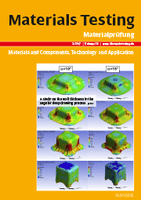
Materials Testing
Empowering Research in Mechanics of MaterialsMaterials Testing is a renowned journal published by Walter de Gruyter GmbH, serving the global scientific community in the fields of Materials Science, Mechanical Engineering, and Mechanics of Materials. With an ISSN of 0025-5300 and an E-ISSN of 2195-8572, this journal has been a significant contributor to the discourse on material performance, testing methodologies, and engineering innovations since its inception. The journal is recognized for its rigorous peer-review process and holds a commendable Q2 quartile ranking in multiple categories for 2023, showcasing its impact and relevance in the field. With open access options available, Materials Testing aims to disseminate valuable research findings and practical insights that drive advancements in technology and materials applications. By addressing the latest challenges and developments within the field, this publication serves as an essential resource for researchers, professionals, and students alike, fostering a deeper understanding of material properties and testing techniques.

AIMS Materials Science
Pioneering Open Access in Materials ScienceAIMS Materials Science is an esteemed open-access journal dedicated to advancing the field of materials science. Published by the American Institute of Mathematical Sciences (AIMS), this journal has been a vital resource for researchers, professionals, and students since its inception in 2014. With an ISSN of 2372-0468 and an E-ISSN of 2372-0484, it focuses on disseminating high-quality research in materials science, ranging from general materials science to cutting-edge advancements in innovative materials applications. Currently ranked Q3 in the 2023 Scopus Materials Science (miscellaneous) category, with a ranking of 253/463, AIMS Materials Science strives to provide an open forum for scholarly dialogue and collaboration, ensuring valuable insights are accessible to the global scientific community. The journal's commitment to open access enhances its visibility and reach, further promoting impactful research in this dynamic field.
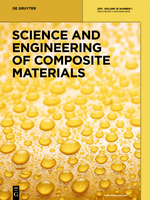
SCIENCE AND ENGINEERING OF COMPOSITE MATERIALS
Transforming Ideas into Innovative Composite SolutionsScience and Engineering of Composite Materials is a highly regarded open-access journal published by De Gruyter Poland SP Z O O, dedicated to advancing research in the field of composite materials. With an ISSN of 0792-1233 and an E-ISSN of 2191-0359, this journal has been a pivotal platform for the dissemination of innovative studies since its inception in 1988, now spanning over three decades of scholarly contributions. Operating out of Germany, it provides unrestricted access to high-quality articles that enhance the understanding of ceramics, composites, and materials chemistry, currently categorized in the Q3 quartile for both domains as of 2023. The journal is indexed in Scopus, where it ranks 67 out of 127 in the materials science ceramics and composites category and 181 out of 317 in materials chemistry. Researchers, professionals, and students are encouraged to leverage this vital resource to stay abreast of cutting-edge developments in composite material science and engineering, fostering knowledge sharing and collaboration in a rapidly evolving field.

MATERIALS SCIENCE AND TECHNOLOGY
Advancing the Frontiers of Materials InnovationMATERIALS SCIENCE AND TECHNOLOGY is a leading journal published by SAGE PUBLICATIONS INC, focusing on the interdisciplinary advancements in the field of materials science. Since its inception in 1984, the journal has provided a platform for researchers and industry professionals to present innovative findings through rigorous peer-reviewed articles. The journal holds a commendable impact factor and categorizes itself within the prestigious Q2 rank in various domains such as Condensed Matter Physics, Materials Science, Mechanical Engineering, and Mechanics of Materials according to the 2023 Quartiles. With no Open Access option, it primarily serves as a repository for in-depth studies and advancements that push the boundaries of materials engineering and application. Located in the United Kingdom, at 2455 TELLER RD, THOUSAND OAKS, CA 91320, the journal continues to attract a global readership, making it indispensable for academics, researchers, and students who aim to stay at the forefront of materials innovation.